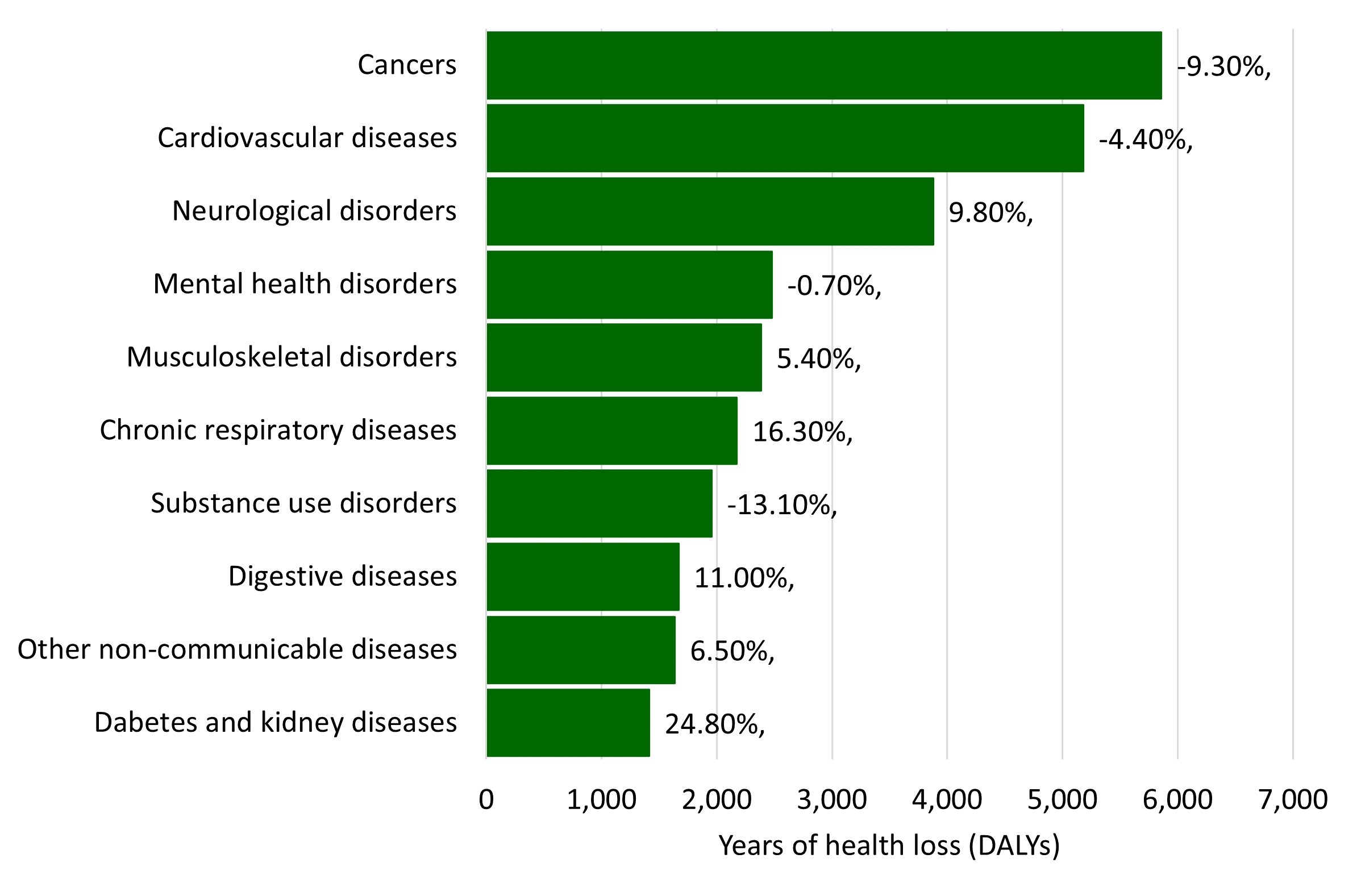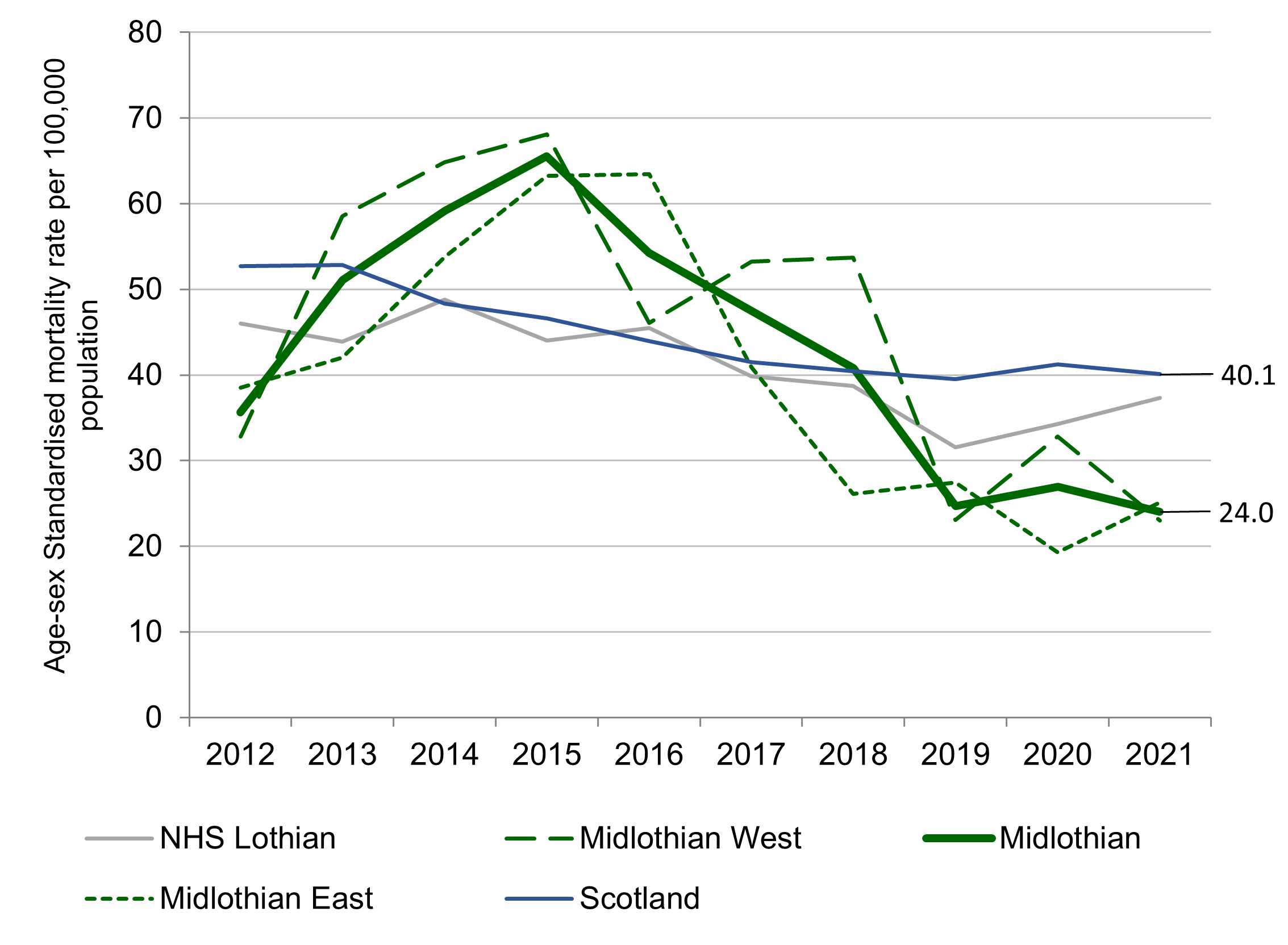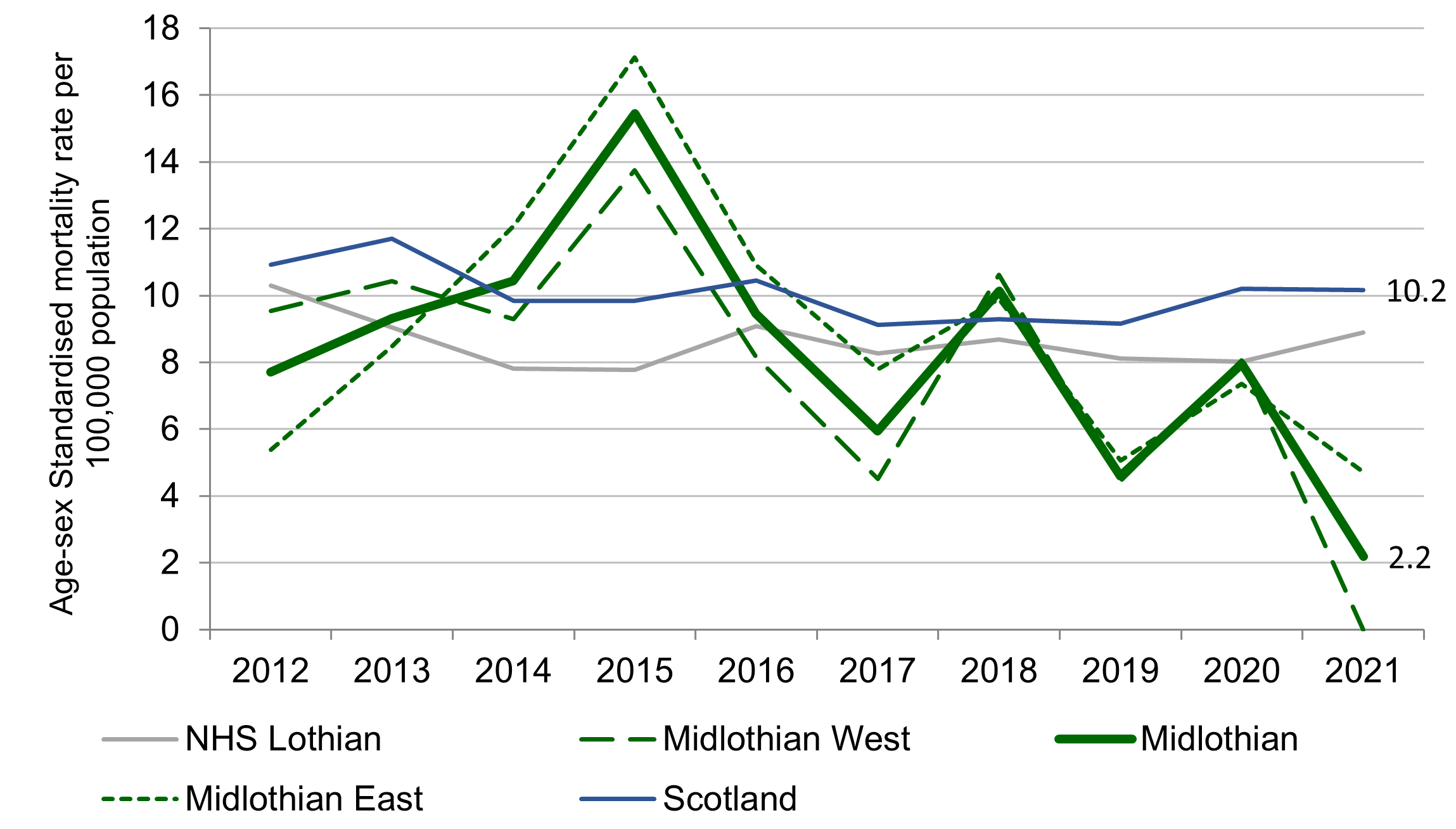Health Conditions - Data
What you told us
- Patient Feedback for the Community Respiratory Team 2021 (PDF)
- Consultation and Engagement Report for Long Term Conditions for the Strategic Plan 2022-25 (PDF)
Impact Assessments
What the data tells us
Burden of Disease studies assess how ill-health and early death due to disease and injury prevent us from living longer and healthier lives. They use a single measure of health loss which combines the years lost to ill-health (years lived with disability) and the years lost due to early death (years of life lost). This measure is called the disability-adjusted life year (Public health Scotland, 2022).
The three largest causes of ill-health and early death in Midlothian are cancers, cardiovascular diseases, and neurological disorders (Public Health Scotland, 2022). These groups of causes account for 46% of the total burden of health loss. This is very similar to the rest of Scotland but there are some differences in Midlothian. The largest are due to diabetes and kidney diseases, chronic respiratory diseases and substance use disorders.
Leading grouped causes of ill health and early death
Data source: Public Health Scotland 2022

Health inequalities
Deaths in lower SIMD quintiles are more likely to be by avoidable deaths. The rate of health loss in the most deprived 5th of the population in the West region was 1.9 times higher than the rate in the least deprived 5th of the population. 47% of the health loss in the most deprived 5th of the population in the West region could have been avoided if the population in this quintile experienced the same rate as those in the least deprived 5th of the population (Public Health Scotland, 2022).
The leading causes of ill health and early deaths in the most deprived quintile are:
- Drug use disorders (9%),
- Ischaemic heart disease (7.5%)
- Lung cancer (6.5%).
The leading causes of ill health and early deaths in the least deprived quintile are:
- Alzheimer's disease and other dementias (7.4%),
- Ischaemic heart disease (7.2%)
- Low back and neck pain (5%).
Cancer
Between 30-50% of all cancer cases are preventable (World Health Organization, 2023). Prevention offers the most cost-effective long-term strategy for the control of cancer.
Cancer is the second leading cause of death globally, accounting for an estimated 9.6 million deaths (one in six deaths), in 2018 (World Health Organization, 2023). More people are surviving longer and living with cancer as a long-term condition.
In Midlothian between 2015 and 2019, and excluding non-melanoma skin cancers, 86.3% people diagnosed with cancer survived for at least 5 years (Public Health Scotland, 2019).
Bowel screening rates:
- Average - 65.4% average from 2018 to 2020, similar to the Scottish rate. Rates have steadily increased since 2018 (with the exception of SIMD 2), increasing from 65.4% to 68.5% overall by 2021.
- SIMD - there is a large gap between uptake rates in the most and least deprived areas that has decreased slightly from 21.2% to 19.2%. Uptake in the 2 lowest SIMD groups are below the national target of 60%.
- Age - rates vary by age with 72.4% of over 75s taking up screening compared with 65.4% of 50–64-year-olds. Uptake rates increased across all ages groups (50+) between 2018 and 2021.
Breast screening rates:
- SIMD - uptake rates are lower in populations with higher levels of deprivation, with uptake in the least deprived quintile, SIMD 5, over 16% higher (77.4%) than in the most deprived quintile SIMD 1 (61.1%). The gap between uptake rates in the most and least deprived has remained fairly constant over the 2016/17 to 2019/20 period, decreasing slightly from 17.5% to 16.4 %. Uptake in the 2 lowest SIMD groups are below the national target of 70%.
Cervical screening rates
- Uptake - 76% in 2020/21
- Age/Sex - there was a higher uptake amongst women in the 50-64 age group (77.8%) than the 25-59 (74.8%).
- SMID - uptake in the 2 lowest SIMD groups are below the national target of 80%
- Age - those aged 50-64 have a higher cervical screening uptake compared to those aged 25-49 at the equivalent SIMD quintile.
Diagnosed cancers
3,438 people in Midlothian were living with cancer (2019) and had been diagnosed within the previous 20 years (3.72% of the population). This is slightly higher than the national figure of 3.64% (Public Health Scotland, 2021). In the 5 years from 2015-2019, there were 2,691 cancers (excluding non-melanoma skin cancer) diagnosed in Midlothian.
- Sex - 49% (1,352) of diagnoses were in men and 51% (1,339) were in women.
- Localities - 54% of diagnoses were in West and 46% were in East (Macmillan Improving the Cancer Journey, 2022).
- The 6 most common types of cancer account for 62% of all cancer diagnosis in Midlothian. These are:
- Trachea, bronchus and lung cancer (this has seen a downward trend in deaths. There is a difference between East and West Midlothian)
- Female breast cancer (this is similar to the Scottish average)
- Colorectal cancer (this has seen an increase in deaths and is similar to the Scottish average)
- Prostate cancer
- Head and neck cancer
- Malignant melanoma of skin
Cancer registration rates
Registration rates appear to have remained stable when adjusting for age and sex per 100,000 population - ranging from 519 in 2010-12 to 545 in 2018-20
Diagnosis of cancer
- Date - There appears to be a downward trend in diagnoses in cancer before the pandemic with overall rates in 2013-2015 at 681 and rates in 2017-2019 at 614.
- Locality - There appears to be no difference in diagnoses and whether you live in East or West Midlothian.
Increase in cancer rates
Given the number of people living with cancer in Midlothian in 2018 and Midlothian’s continued growing population, cancer rates are predicted to increase from 3,374 in 2018 to 4,237 in 2038.
All cancer (excludes non-melanoma skin cancers) European age-standardised mortality rates, Midlothian locality, NHS Lothian, and Scotland 2011-2020.
Data Source: Scottish Cancer Registry Public Health Scotland

Inequalities
Socio-economic deprivation can influence cancer survival as people living in a more deprived area can be diagnosed at a later stage when survival is poorer (Public Health Scotland). This is most evidence in trachea, bronchus and lung cancer with 60% of lung diagnoses in SIMD quintiles 1 & 2. Others include 42% breast diagnoses and 40% of prostate diagnoses in SIMD quintiles 1 & 2.
Out of the total 2,691 diagnoses of cancer between 2015 – 2019, 1269 (47.9%) of Midlothian were in the two most deprived SIMD groups. SIMD group 1 and 2 make up roughly 41% of the Midlothian population.
Support for people affected by cancer
In 2023, Improving the cancer journey (ICJ) has supported 240 people and had 191 referrals (including 22 carers /family) with a range of health and social care support. The top 5 concerns of people with cancer in Midlothian (in order) were money or finance, anxiety, fatigue, uncertainty and thinking about the future.
Midlothian Macmillan Welfare Rights Partnership in 2022/2023 total financial gains for people with cancer were £526,772.73 plus an additional £6,880 Macmillan Grants via ICJ totalling £533,652.73. A total number of 237 clients were assisted by the Welfare Rights Partnership, 95 of these clients were terminally ill which equates to 40% of the case load.
Respiratory Conditions
Respiratory conditions are those which affect the airways and other structures of the lung. Although 'respiratory condition' is a general term used to describe a large group of conditions, five conditions (Asthma, Bronchiectasis, Chronic Obstructive Pulmonary Disease, Idiopathic Pulmonary Fibrosis and Obstructive Sleep Apnoea Syndrome) make up 90% of the burden of respiratory disease in Scotland (Scottish Government, 2021.)
Asthma
Asthma is a long-term common lung condition which affects the airways and impacts breathing. In 2021/22 the prevalence rate of people with Asthma in Midlothian was 6.74 per 100 population, which is comparable to the Scottish rate is 6.35 (Public Health Scotland, 2022). Asthma prevalence has reduced in Midlothian over last 2 years from 7.3 to 6.74 per 200 population (Public Health Scotland, 2022).
Chronic Obstructive Pulmonary Disease (COPD)
COPD is an umbrella term used to describe progressive lung diseases including emphysema, chronic bronchitis, and refractory (non-reversible) asthma. COPD is a progressive and (currently) incurable disease, but with the right diagnosis and treatment, there are many things that can be done to manage COPD. People can live for many years with COPD with a good quality of life. COPD is under-diagnosed in most populations, with a diagnosis often only being established in the moderate to severe stages of the disease (ScotPHO, 2022). Therefore, routine data may underestimate the true extent of COPD within any given population. The prevalence of COPD has reduced in Midlothian for the last 2 years from 2.74 in 2019/20 to 2.59 per 100 population in 2021/22 (ScotPHO, 2022). Midlothian ranks 9th highest out of 26 HSCPs for COPD prevalence and has a higher prevalence rate than the Scotland average of 2.39 (Public Health Scotland, 2022).
COPD patient hospitalisation data indicates there are a higher number of people admitted with COPD in areas where people are more likely to experience disadvantage. For example, the prevalence is 70.11 per 100,000 population in Penicuik North and 235.35 per 100,000 population in Dalkeith (3-year aggregate figure 2019/20 to 2021/22) (Public Health Scotland, 2022). There were 151 potentially preventable admissions to hospital in 2019/20 for COPD (Public Health Scotland, 2022).
Neurological Conditions
Neurological conditions, disorders and syndromes affect the brain, spinal cord, nerves and muscles. Examples include Multiple Sclerosis, Parkinson’s disease, Huntington’s disease, Motor Neurone Disease, epilepsy, seizures, chronic headache and migraine, acquired brain injury, dystonia, functional neurological symptoms, cerebral palsy and muscular dystrophy. Neurological conditions are the most common cause of serious disability in Scotland.
There is no reliable data on the number of people with a neurological condition and most services are co-ordinated at a Lothian level. A statistical estimate suggests there could be 5,300 people with a condition, 530 of whom will be disabled by the condition (Neurological Alliance, 2003). Neurological conditions account for between 10% and 20% of acute medical admissions in Scotland (Association of British Neurologists, 2017) and 10% of the overall burden of disease in Scotland, as measured by disability-adjusted life years (Scottish Public Health Observatory, 2017).
Multiple sclerosis
The prevalence rate for multiple sclerosis in Scotland is 209 per 100,000 (Multiple Sclerosis Trust, 2023). This would suggest an estimate of 188 people have multiple sclerosis in Midlothian. Scotland has one of the highest rates of multiple sclerosis in the world compared to a worldwide prevalence rate of 35.9 per 100,000 population (Walton et al., 2020). The proportion of women being diagnosed with multiple sclerosis is increasing - between two and three women have been diagnosed with multiple sclerosis for every man with the condition (Multiple Sclerosis Trust, 2023).
Parkinson’s disease
The prevalence rate for Parkinson’s disease is 1 in every 375 adults in Scotland (Parkinson’s UK, 2023). This would suggest 240 people have Parkinson’s disease in Midlothian. People with Parkinson’s disease have a particularly high risk of hospital admission and are 6 times more likely to develop dementia as people of the same age without the condition (Parkinson’s UK, 2023). Nationally numbers are continuing to rise for both Multiple Sclerosis and Parkinson’s Disease. This is linked to people living longer with these conditions.
Huntington’s Disease
The average prevalence rate for Scotland is 16.1 people in every 100,000 from 1990-2010 (Evans et al., 2013). This would suggest 14 people have Huntington’s Disease in Midlothian (Scottish Huntington Association, 2023). The Scottish Huntington's Association reported a 55% increase in diagnoses between 2012 and 2015.
Motor Neurone Disease (MND)
There is little published research describing prevalence of MND. Current estimates of MND prevalence in Scotland suggest between 300-450 people living with MND in Scotland at any given time (5.5 to 7.4 per 100,000) (ScotPHO, 2016). In Scotland incidence rates are higher than reported elsewhere and survival rates are lower (ScotPHO,2016). The median survival time for motor neurone disease in Scotland is 25 months (ScotPHO, 2016).
Stroke
A stroke occurs when the blood supply to part of the brain is compromised, often by a blood clot blocking an artery or a ruptured blood vessel. The effects of a stroke may alter someone's ability to move, feel, think, communicate, and function.
The risk of a stroke can be reduced through a healthy lifestyle such as eating a healthy diet, taking regular exercise, drinking alcohol in moderation, and not smoking. Certain conditions increase the risk of having a stroke, including high blood pressure, high cholesterol, irregular heartbeat and diabetes.
The raw prevalence rate in Midlothian (the number of people registered at one particular point in time) for stroke/TIA is 2.42 per 100 patients which equates to around 1,943 people (Public Health Scotland 2022). This is above the Scottish average prevalence rate (2.21) (Public Health Scotland 2022). Nationally the death rate for cerebrovascular disease in the most deprived areas was 46% higher than in the least deprived areas in 2019 (Public Health Scotland 2023).
74% of people were discharged to their own homes after admission to hospital for a stroke/TIA and 16% were discharged to a care home (VOCAL, 2017). 50% of people were discharged within 3 days or less (April 19-Aug 20) (VOCAL, 2017)
All Age Stroke Mortality, Midlothian Locality, NHS Lothian and Scotland
Data source: Public Health Scotland.

Early (<75) Stroke Mortality, Midlothian Locality, NHS Lothian and Scotland
Data source: Public Health Scotland

Diabetes
Diabetes is an important cause of disability, it increases the risk of coronary heart disease and other health problems (ScotPHO, 2022).
Over 317,000 people have a diagnosis of diabetes in Scotland in 2020 (Scottish Diabetes Survey), a crude prevalence of 5.8% (compared to 5.1% in 2013). This represents an increase of over 4,700 people since 2019.
- Type 1 diabetes often starts at a young age and is due to a lack of insulin. It accounts for 10-15% of all cases of diabetes (10.7% in Scotland in 2020) (ScotPHO,2022).
- Type 2 diabetes starts with resistance to the action of insulin and is associated with older age, being overweight and obesity (ScotPHO, 2022).
Approximately 80% of diabetes complications are preventable or can be significantly delayed through early detection, good care and access to appropriate self-management tools and resources. In England, obese adults are five times more likely to be diagnosed with diabetes than adults of a healthy weight (Public Health England, 2014).
Diabetes care accounts for around 10% of all NHS expenditure. If no changes are made to the way diabetes is treated by 2035 ⁄ 2036, it is estimated that this will rise to around 17% of NHS expenditure (Hex et al., 2012).
Number of people in Midlothian with Diabetes
- Sex - there was a higher proportion of males (55.95%) than females (44.05%) with type 2 diabetes between 2015/16 and 2020/21.
- Age - Type 2 diabetes is most prevalent in older people but increasing numbers of younger people are being diagnosed.
Inequalities
- The group with the highest rate (per 100,000) of diagnosis are those in SIMD 5 (2015/16 - 2022/23)
- SIMD 1 - 214
- SIMD 2 - 898
- SIMD 3 - 599
- SIMD 4 - 410
- SIMD 5 - 259
Page updated: September 2024
